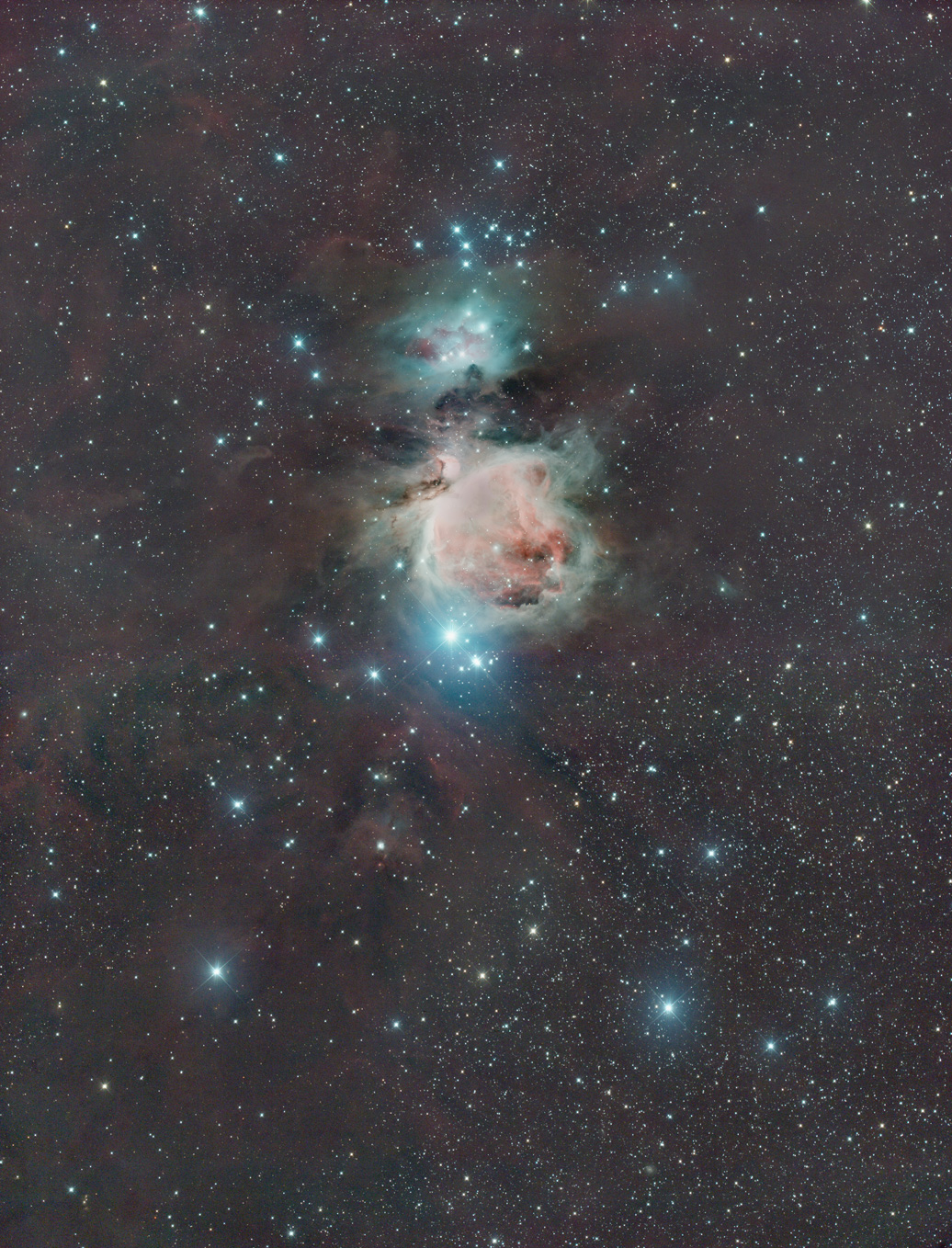Deep Sky Object in Winter
M42 (The Great Orion Nebula)
Click on image to enlarge
| Date & Time: | Nov 20 2009, from 26:45 to 28:34 JST(+0900) |
| Mosaic of 2 flames of 10min×4, 2min×4 & 30sec×4 shots exposed |
| Optical: | VIXEN 20cm(7.9") VISAC with a conversion lens (f=1278mm, F6.4) |
| with BaaderPlanetarium Moon & Skyglow filter |
| Auto-guided with VIXEN ATLUX Equatorial & Meade Pictor 201XT |
| Digital Camera: | Nikon D50 (Remodeled) |
| Location: | Ooizumi, Hokuto city, Yamanashi pref. |
| Camera Settings: | Recording Format...12bit CCD-RAW, converted to 16bit TIFF(3008×2000) |
| CCD Sensitivity...ISO1600 |
| M42 (NGC1976) / Diffused Nebula, type 1 E |
|---|
| R.A. | 05h 35m 24.0s (2000.0) |
|---|
| Dec. | -05° 27' 00" (2000.0) |
|---|
| Apparent Size | 66×60' |
|---|
| Real Size | 25×23 light yrs. |
|---|
| Magnitude | 4.0 |
|---|
| Distance | 1300 light yrs. |
|---|
| Other IDs | Sh2-281, LBN974 |
|---|
M42, The Great Orion Nebula, positioned below Orion's belt, is the one of most attractive and photographed objects in the sky.
I tried to capture this object into film by using of a telescope at the first time.
Perhaps you can remind this vast nebula of a shining bird with its wings spread out.
Actually, M42 occupies only area of this bird's body, and a part of head is named M43 as a detached part of the Orion Nebula.
A dark lane separates M43 from M42, although the two are part of the same vast stellar cloud.
You can detect the fascinating four-star system known as The Trapezium with medium sized telescopes
(It's invisible in this picture because of over-exposure) in the central region, it's very young stars appear from this gas and dust exquisitely lit by surrounding stars.
⇒ Display the spectral profile of M42 (in new window)
|
Click on image to enlarge
Magnified image of central M42 (The Trapezium)
| Date & Time: | Dec 10 2020, from 22:47 to 22:50 JST(+0900) |
| HDR-composed 20 shots with 30sec.×5, 10sec.×5, 5sec.×5, 2sec.×5 |
| Optical: | Meade 25cm(10") Schmidt-Cassegrain with conversion lens (f=1600mm, F6.3) |
| with BaaderPlanetarium Moon&Skyglow filter |
| Auto-guided with Meade LX200 Equatorial & Lacerta M-GEN |
| CMOS Camera: | ZWO ASI183MC |
| Location: | Ooizumi, Hokuto city, Yamanashi pref. |
| Camera Settings: | Recording format...32bit FITS, converted to 16bit TIFF(5496×3672) |
| Device Size...13.2×8.8mm, Gain...400 |
This picture shows you a magnified image of the center of Great Orion Nebula.
You can detect the Trapezium of four 5th to 8th magnitude stars. They have IDs from A to D in the order of their right ascention (from right to left).
Now we have recognized the Trapezium as a small-scaled open cluster positioned in M42.
Click on image to enlarge
Wide-field image of M42
| Date & Time: | Nov 29 2019, from 26:48 to 28:29 JST(+0900) |
| 18 shots composed with 4min.(ISO3200)and 1min.(ISO3200 & 1000) exposed |
| Mosaic of 2 flames |
| Optical: | TAKAHASHI 16cm(6.3") epsilon (f=530mm, F3.3) |
| with IDAS LPS-D1 light-pollution suppression filter |
| Auto-guided with TAKAHASHI JP Equatorial & SBIG STV |
| Digital Camera: | Canon EOS 6D (Remodeled) |
| Location: | Ooizumi, Hokuto city, Yamanashi pref. |
| Camera Settings: | Recording Format...12bit CCD-RAW, converted to 16bit TIFF(5472×3648) |
| Device Size...36×24mm, Sensitivity...ISO1000 & 3200 |
This field image shows you span of about 2 by 3 degrees with the Great Orion Nebula in center.
And I have emphasized indistinct diffused nebulae in outskirts.
Especially it has full of nebulosity in east region of the field, these gaseous matters are distributed toward the Barnard's Loop in far east out of this field.



